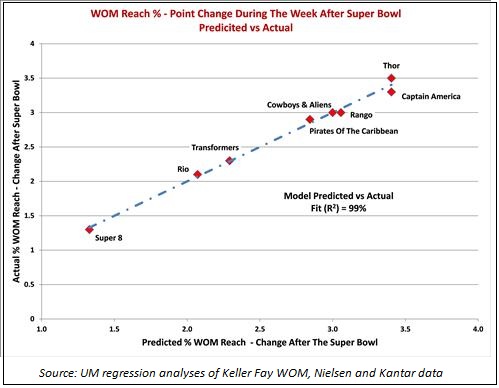Maximizing a Super Bowl Ad's Word of Mouth - Graeme Hutton-UM

Have you ever wondered how to maximize the word of mouth from your Super Bowl ad? The Super Bowl remains the most watched annual TV event in the United States – an average of 44% of all homes watched last year. It's not so much a TV show as a major cultural phenomenon. Its ability to boost a brand's word of mouth has reached almost mythical proportions ever since Apple's 1984 commercial heralded the launch of the Macintosh computer.
Have you ever wondered how to maximize the word of mouth from your Super Bowl ad? The Super Bowl remains the most watched annual TV event in the United States – an average of 44% of all homes watched last year. It's not so much a TV show as a major cultural phenomenon. Its ability to boost a brand's word of mouth has reached almost mythical proportions ever since Apple's 1984 commercial heralded the launch of the Macintosh computer.
Let's assume for one moment that we have a great ad, a creative asset that resonates well with the consumer. Is that enough? Our initial regression modeling suggests that besides a great ad, just maximizing the audience rating may not be enough. Critically, the quarter of the game that the ad appears in and securing the first position in the pod also count. In addition, :5 billboards, those announcements often seen at the beginning or end of an ad pod, may be an unnecessary luxury and, from the perspective of WOM value, possibly not worth the additional investment.
In 2010, UM won the Word of Mouth Marketing Association's (WOMMY) Gold Award for Research for its paper quantifying how Sony Electronics' media advertising helped boost its word of mouth. Through a multivariate analysis, we determined two key insights that had never been publicly demonstrated before:
1. Brand advertising has a direct effect on the effectiveness of word of mouth. In this instance, 14% of all Sony Electronics' WOM was attributable to its own media activity.
2. A brand's word of mouth is not just affected by its own ad activity. Competitive share of voice is also a critical factor. In the Sony Electronics model, 23% of Sony's potential WOM was eroded by the impact of competitors' advertising activity.
If we apply this type of modeling approach to ads in the Super Bowl, what can it reveal? To determine this, we analyzed the reported word of mouth from Keller Fay's Talk Track Super Bowl study conducted in 2011. Keller Fay takes a unique approach in the world of buzz trackers in that it captures both online and offline word of mouth. Keller Fay was the data source fuelling the award winning WOMMY study. For the Super Bowl, Keller Fay specifically tracked 42 ads in the game with sample of 3000 individuals boosted during the week after the game with a custom survey.
It is well-known that word of mouth levels vary substantially by market category. Additionally, since several advertisers had multiple placements and various commercial time-lengths in the Super Bowl, we decided to focus on one category where these variables would be minimized. We chose to probe the movie sector since not only did this eliminate any cross-category effects, we were able to substantially reduce the variations from ad to ad. For example, there was only one ad for each film title and 30 seconds was the only commercial time-length utilized by all movie marketers. This enabled us to isolate the core media drivers of movie mentions as a direct result of their Super Bowl advertising.
To analyze the effects of the Super Bowl, we built a database of factors such as 18-54 TV rating, the game quarter in which the ad appeared, ad position in pod, use of billboards plus the word of mouth for each movie in the week after the Super Bowl that we applied to each ad. Interrogating this database via regression analysis, this is what the model revealed:

The model's projection is very encouraging with a 99% fit between predicted and actual word of mouth. While one core factor was audience rating, it was also bolstered by the quarter in which the ad appeared – the earlier the better. We also saw that being first in pod provided great impetus to an ad's WOM. By contrast, the often highly prized position of last in pod did not materially help WOM; indeed it actually reduced the ad's effectiveness!
The jury remains out on billboards. In our best model, displayed in this column, billboards did not help word of mouth reach, i.e. the net number of people discussing the ad, but in other models, the gross volume or frequency of conversations were helped by billboards.
For UM, the surprising reveal of this analysis is the low value of word of mouth derived from being placed last in pod – a media position which, otherwise, can often be highly regarded. We hope to build and share on this analysis in future years. 2012 should be another great year for Super Bowl advertising and its legend ability to motivate consumers to talk about brands.
Graeme is SVP, Director of Consumer Insights & Research, Graeme is responsible for ensuring that all appropriate proprietary and syndicated research tools and resources are applied in the development of consumer insight strategies, for a total communications research platform--from TV to chat rooms--which informs the efforts of Universal McCann and its agency partners. Graeme can be reached at Graeme.hutton@umww.com
Read all Graeme's MediaBizBloggers commentaries at Curious Thoughts from Curious Minds.
Check us out on Facebook at MediaBizBloggers.com
Follow our Twitter updates @MediaBizBlogger
The opinions and points of view expressed in this commentary are exclusively the views of the author and do not necessarily represent the views of MediaBizBloggers.com management or associated bloggers. MediaBizBloggers is an open thought leadership platform and readers may share their comments and opinions in response to all commentaries.


